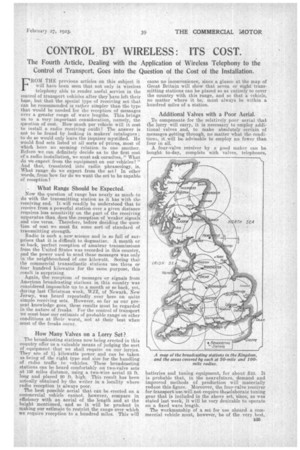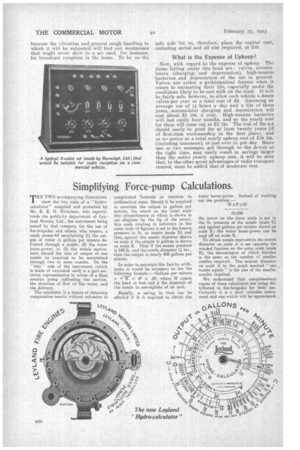• CONTROL . BY WIRELESS: ITS COST.
Page 9

Page 10

If you've noticed an error in this article please click here to report it so we can fix it.
The Fourth Atticle, Dealing with the Application of Wireless Telephony to the Control of Transport, Goes into the Question of the Cost of the Installation.
FROM THE previous articles on this subject it will have been seen that not only is wireless telephony able to render useful service in the control of transport vehicles after theihave left their base, but that the special type of receiving set that can be recommended is rather simpler than the type that, would be needed or the reception of messages over a greater range of wave lengths. This brings us to a very important consideration, namely, the question of cost. How much per vehicle will it cost to install a radio receiving outfit? The answer is not to be found by looking in makers' catalogues ; to do so would only leave the inquirer mystified. He would find sets listed at all sorts of prices, most of which bore no seeming relation to one another. Before we can definitely decide as to the first cost of a radio installation, we must ask ourselves, " What do we expect from the equipment on our vehicles? " And that, translated into radio phraseology, is, 'What range do we expert from the set? In other words, from how far do we want the set to be capable of reception? '
. What Range Should be Expected.
Now the question of range has nearly as much to do with the transmitting station as it has with the receiving end. It will readily be understood that to receive from a powerful station over a given distance requires less sensitivity on the part of the receiving apparatus than does the-reception, of 'weaker signals and vice versa. Therefore, before deciding the question of cost we must fix some sort of standard of transmitting strength.
Radio is such a new science and is so full of surprises that it is difficult to dogmatize. A month or so back, perfect reception of amateur transmissions from the 'United States was recorded in this country, and the power used to send these messages was only in the neighbourhood of one kilowatt. Seeing that lhe commercial transatlantic stations use three or four hundred kilowatts for the same purpose, this result is surprising. Again, the reception of messages or signals from American broadcasting stations in this country was considered impossible up to a month or so back, vet, during last Christmas week, WJZ, of Newark, blew Jersey, was heard repeatedly over here on quite simple receiving sets. However, so far as our present knowledge goes, these results must be regarded in the nature of freaks. For the control of transport we must base our estimate of probable range on ether conditions at their worst, not at their best, when most of the freaks occur.
How Many Valves on a Lorry Set?
The broadcasting stations now being erected in this country offer us a, valuable means of judging the sort of equipment that we shall require on our lorries. They are of 1i kilowatts power and can be taken as being of the right type and size for the handling of radio traffic to vehicles. These broadcasting stations can be heard comfortably on two-valve sets at 150 miles distance, using a two-wire aerial 65 ft. long and placed 20 ft. high. This result has been actually obtained by the writer in a locality where radio reception is always poor. The best possible aerial that can be erected on a commercial vehicle cannot, however, compare in efficiency with an aerial of the length and at the height mentioned, and so it will be prudent in making our estimate to restrict the range over which we require reception to a hundred miles. This will cause no inconvenience, since a glance at the map of Great Britain will show that seven or eight transmitting stations can be placed so as entirely to cover the country with this range, and so that a vehicle, no matter where it be, must always be within a hundred miles of a station.
Additional Valves with a Poor Aerial.
To compensate for the relatively poor aerial that the lorry will carry, it is necessary to employ additional valves and, to make absolutely certain of messages getting through, no matter what the eonditions, it will be advisable to employ no fewer than four in all.
A four-valve receiver by a good maker can be bought to-day, complete with valves, telephones,
batteries and tuning equipment, for about £45. It is probable that, in the near4future, demand and improved methods of production will materially reduce this figure. Moreover, the four-valve receiver for transport use will not require thselaborate tuning gear that is included in the above set, since, as was stated last week, it will be very desirable to operate on a fixed wave length.
The workmanship of a set for use abeard a commercial vehicle must, however, be of the very best, B25 because the vibration and general rough handling to which it will be subjected will find out weaknesses that might never show in a set used, for instance, for broadcast reception in the home. To be on the
safe side -let us, therefore, place the capital cost, including aerial and all else required, at 240.
What is the Expense of Upkeep?
Now, with regard to the expense of upkeep. The items falling under this head are : valves, accumu• lators (charging 4 and depreciation), high-tension batteries. and depreciation of the set in general. Valves are rather a, problematical feature when it comes to estimating their life, especially under the conditions likely to be met with on the road. It will be fairly safe, however, to allow each vehicle a dozen valves per year at a total cost of 29. Assuming an average use of 14 hours a day and a life of three years accumulator charging and depreciation will cost Et, bout 23 10s. a year. High-tension batteries will last easily four months, and so the yearly cost for these will come out at 23 12s. The rest of the set should easily he good for at least twenty years (if of first-class workmanship in the first place), and so we arrive at a total yearly upkeep cost of 218 12s. (including insurance), or just over Is. per day. Since one or two messages, got through to the driver at the right time, may easily result in savings larger than the entire yearly upkeep cost, it will be seen that, to the other great advantages of radio transport control, must be added that of moderate cost.




























